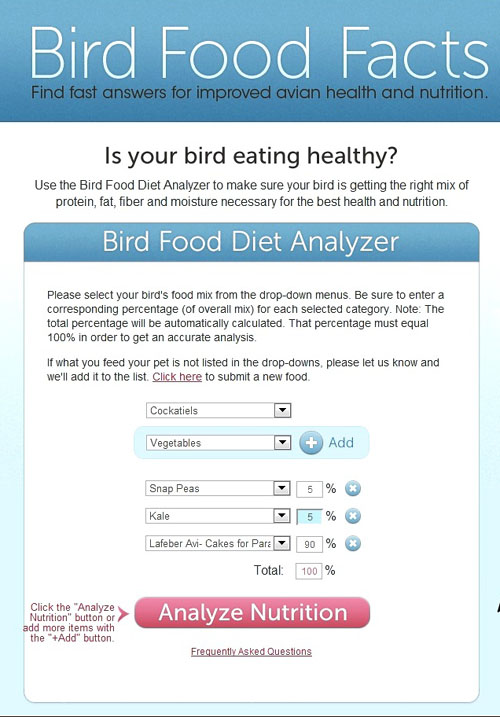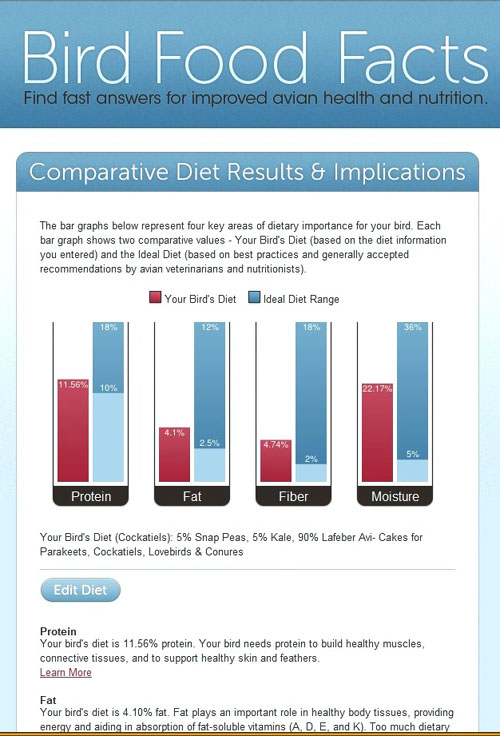|
Bird Food Facts
Have you ever wanted to know more about what you feed your bird? And what would happen if you adjusted the diet? Well, ZuPreem has come up with a great new site called BirdFoodFacts.com that calculates the content of your bird's diet for you!
After selecting a species, you select a food category. The first menu has fruit, meat/eggs/protein, miscellaneous, nuts/beans/seed, packaged bird food, and vegetables. You add the category, and then a submenu shows up. There are 30 types of fruit, 15 types of meat/eggs/protein, 64 types of miscellaneous items, 38 types of nuts/beans/seed, and 27 types of vegetables listed currently. The list of packaged bird foods is enormous, with products from 17 major bird food companies. I presume these lists are being expanded over time. If you feed your bird something not on the list, pick something close. So, for example, I feed my birds Swiss chard, which s not listed, so I chose kale as a close approximation. There's a link to click on if you want them to add a food not already listed. I've shown screenshots here of a sample diet for my cockatiels. (Note - after writing this article, I asked them to add Swiss Chard, and they did!) After you pick a food item, it asks you to enter the percentage of the diet this item represents. Once you've entered one item, go up to the main menu and pick the next item to add. Repeat this until you've entered the bird's total diet. Your birds may not get the exact same diet each day, so try to pick a sample diet. Not all treat items are listed (though you can always request that they be), but these should not represent a significant portion of the diet or they wouldn't be treats. Note that there are many things on the miscellaneous list, in particular, that shouldn't be part of any bird's diet, like cheese puffs (salt!), donuts (sugar!), and iced tea (caffeine!), but are included so that you can honestly evaluate your bird's diet. Once you have a list that adds up to 100%, click on the Analyze Nutrition button. A screen pops up giving you comparative diet results and implications. There are four sets of bar graphs analyzing your birds' diet for protein, fa While this site is sponsored by ZuPreem, that is not obvious, and only one little comment on the side mentions that they are the "No. 1 selling pelleted bird food brand in the U.S." The site is surprisingly free of commercial bias, with most major bird food brands represented. It would be nice to see vitamin and mineral analysis also in addition to the four categories provided, but the information on this site is quite useful. Perhaps this will be coming down the line. I strongly encourage everyone to try analyzing your bird's diet so you can see what you're really feeding your bird. Keep in mind that the percentages you enter are what the bird is actually eating, not necessarily what you provide. Also, with seed mixes, your bird may be picking out certain seed items selectively, so the analysis may not be totally accurate. And while that almond or grape may not look like much, it could be a bigger part of your bird's diet by percentage than you think it is, so try to be honest about what you enter. One of the best uses of this site is to compare diets so you can see what effect a change has, rather than just looking to see if the diet falls within range. So, for example, if I edit the diet above to be 80% Avi-Cakes with 10% French fries and 10% grapes, the diet is still within range, but the fat went up from 4.1% to 5.23%, and the protein dropped from 11.56% to 10.45%, indicating a diet going in the wrong direction. But if I had just entered this as the only diet, I might believe that this is a healthy diet, which is not true. So the lack of information on overall health of the diet, particularly with regard to salt, vitamins, and minerals, can be misleading. Still and all, this is a great new resource provided by the people at ZuPreem which will help all of us be more knowledgeable about what we are feeding our birds. I encourage everyone to give it a try! Amy Hopkins |
|
|
Membership | Events
& News | Adoption Information
| Classified
Ads | Library |
Board Members
Contact info@theparrotclub.org with
questions or comments. |



